| Praga E-39 | |
|---|---|
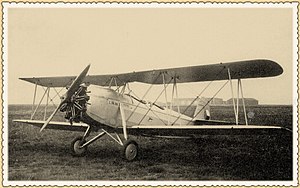 | |
| General information | |
| Type | Primary trainer, reconnaissance aircraft |
| Manufacturer | ČKD-Praga |
| Designer | Pavel Beneš and Miroslav Hajn |
Praga E-39/BH-39 was a Czechoslovak trainer aircraft. [1]
| Praga E-39 | |
|---|---|
 | |
| General information | |
| Type | Primary trainer, reconnaissance aircraft |
| Manufacturer | ČKD-Praga |
| Designer | Pavel Beneš and Miroslav Hajn |
Praga E-39/BH-39 was a Czechoslovak trainer aircraft. [1]
This aircraft was designed by Pavel Beneš and Miroslav Hajn, engineers at the Czech aviation company ČKD-Praga in 1931. [2] It flew for the first time in June of that year. The biplane, standard configuration for that era, was an immediate success and orders were placed by the Czechoslovak Air Force that used them as elementary training aircraft at its flight schools throughout the 1930s. Pre-World War II production of the machine was 139 units. [3] In 1939 following the German occupation of Bohemia and Moravia, Slovakia became an independent country. It was a German ally and its small air force was placed under Luftwaffe control. Ten of the Praga E-39s were initially used as trainers by the Slovak Air Force. [4] During the German invasion of the Soviet Union they were transferred to the Soviet front where they were employed by the Slovaks as reconnaissance platforms in support of German ground forces. Other E-39s were used by the Luftwaffe in their flight training schools as elementary trainers, and still others were given to the Hungarian Air Force for use in that same role. [4]

Data from Valka.cz [3]
General characteristics
Performance
Related lists
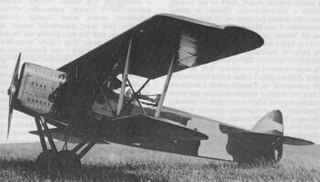
The Aero A.11 was a biplane light bomber and reconnaissance aircraft built in Czechoslovakia between the First and Second World Wars. It formed the basis for many other Czechoslovakian military aircraft of the inter-war period. Around 250 were built, with some remaining in service at the outbreak of World War II.

The Aero A.12 was a Czechoslovakian biplane light bomber and military reconnaissance aircraft manufactured in small numbers shortly after World War I. Although reminiscent of the Hansa-Brandenburg-designed aircraft that Aero was building during the war under licence as the Ae.10, the A.12 was the company's own design. It is perhaps most significant as the direct descendant of the highly successful A.11 and its various derivatives. An example of the type is preserved at the Letecké Muzeum in Kbely.
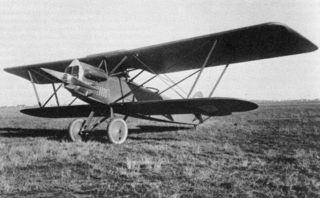
The Aero A.30 was a biplane light bomber and reconnaissance aircraft. It was built in Czechoslovakia in the late 1920s. It originated as an attempt by Aero to improve the performance of the Aero A.11, but soon evolved into quite a different aircraft, larger and more powerful than its predecessor. The aircraft is readily distinguished from other related types, through the difference in spans between its wings – the upper set being of much greater span than the lower.

The Aero A.35 was a Czechoslovakian airliner of the 1920s and 1930s. Designed by Aero for long-range flight, with a transatlantic crossing in mind, it saw service with CSA although no such crossing was ever attempted. It first flew in 1929. A conventional high-wing monoplane, it was a very modern design for its day in all but one respect – the cockpit still had open sides. An extra passenger could also be accommodated here, beside the pilot.

The Aero A.304 was a Czechoslovakian bomber aircraft that first flew in 1937. It had originally been developed as an airliner, the A.204, but when Aero could not find buyers for the design, it was militarised and successfully marketed to the Czechoslovak Air Force.

The Walter NZ 60 was a five-cylinder, air-cooled, radial engine for aircraft use built in Czechoslovakia by Walter Aircraft Engines in the 1920s.

The Walter Venus was a seven-cylinder, air-cooled, radial engine for aircraft use, built in Czechoslovakia in the late 1920s.

The Walter Vega was a five-cylinder, air-cooled, radial engine for aircraft use, built in Czechoslovakia in the late 1920s.

The Avia BH-5 was a two-seat sport aircraft built in Czechoslovakia in 1923. It was based on the firm's experience with the BH-1 and shared that aircraft's basic design: a low-wing, braced monoplane. As a result of its L-BOSA registration, all slow flying Avia monoplanes of the BH-5 lineage were nicknamed Boska. The BH-5 was flown competitively by Zdeněk Lhota at the Belgian Touring Aircraft Contest in Brussels in 1923, and won both the overall prize for the event and the King of Belgium Prize. The same year, it won the first prize in its class in the Czechoslovak President of the Republic Competition.

The Avia BH-17 was a biplane fighter aircraft built in Czechoslovakia in 1924. It was a development of the BH-6 and BH-8, and work on the latter aircraft was cut short in favour of this one. Operational trials in 1924 revealed performance good enough for the Czechoslovak Air Force to place an order for 24 examples. In actual service, however, the BH-17 proved unreliable and was soon withdrawn.

The Avia BH-23 was a prototype night fighter aircraft built in Czechoslovakia in 1926. The design was derived from the BH-21 day fighter, incorporating structural changes made to the BH-22 trainer, and the type was originally designated BH-22N. Searchlights and other night-flying equipment were added, but the Czechoslovak Air Force were not interested in the project and no sale resulted.
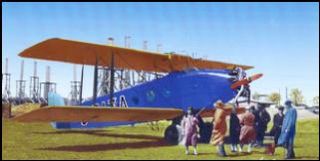
The Avia BH-25 was a biplane airliner built in Czechoslovakia in 1926.

The Avia BH-29 was a trainer aircraft built in Czechoslovakia in 1927, in the hope of marketing it to both the Czechoslovakian Army, and to Czechoslovakian Airlines as a primary trainer. It was an conventional design, an unequal-span biplane of wooden construction and with tailskid undercarriage. The pilot and instructor sat in tandem open cockpits. A more powerful version was built, powered by a 120 hp (89 kW) Walter NZ-120 radial engine.

The Praga BH-41, later redesignated E-41, was a military advanced trainer aircraft produced in Czechoslovakia during the 1930s.
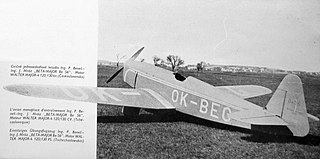
The Beneš-Mráz Be-56 Beta-Major was a single-seat aerobatic advanced trainer manufactured in Czechoslovakia shortly before World War II.

The Praga E-51 is a Czechoslovakian reconnaissance aircraft and light bomber built by Praga in the 1930s. Development was halted by the annexation of Czechoslovakia by Germany, after only one prototype had been built. The appearance of the construction is very reminiscent of the contemporary twin engined fighter, the Fokker G.I from Holland.

The Walter Atlas was a nine-cylinder, air-cooled, radial engine for aircraft use built in Czechoslovakia in the early 1930s.

The Walter NZ 85 was a seven-cylinder, air-cooled, radial engine for aircraft use built in Czechoslovakia by Walter Aircraft Engines in the late-1920s.

The Walter NZ 40 was an unsuccessful, three-cylinder, air-cooled, radial engine for aircraft use built in Czechoslovakia by Walter Aircraft Engines in the late-1920s.

The Walter Minor 12 was a 12-cylinder, air-cooled, V engine for aircraft use built in Czechoslovakia by Walter Aircraft Engines in the late-1930s.